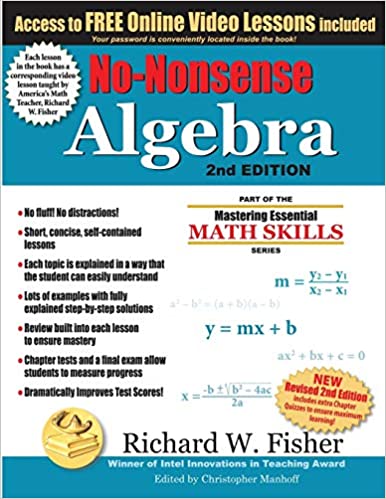No-Nonsense Algebra is part of the Mastering Essential Math Skills series, a series designed to teach and review math skills efficiently. This textbook is available in either English or Spanish as well as in a bilingual edition that contains the same lessons presented in both languages. No-Nonsense Algebra covers the basics of first-year algebra at an easier level than most other courses. It should be most useful for students who need to learn algebra quickly and for review or remediation.
No-Nonsense Algebra is a 295-page, softcover book that includes tests and answer keys. It's consumable, so students can do their work and write their answers in it. In addition to the book, there are free online videos that teach all of the 95 lessons in the book
I did a quick comparison with other Algebra 1 textbooks and found that most of them run around 500 pages or more. There are a few reasons why No-Nonsense Algebra is presented in a briefer book. No-Nonsense Algebra is an easier course than most. For instance, it does not teach about negative exponents, functions, probability, or statistics. It has fewer lessons, and the teaching information is briefer than in many courses. However, the teaching videos for this course each run from about four to twelve minutes, significantly expanding the instructional information. When considering the amount of content, these videos need to be taken into account along with the number of pages. Nevertheless, there are fewer problems to solve than in other courses.
The book presents the course in ten chapters, and each chapter has a number of lessons. Each lesson has an introduction, examples, exercises, and review. The introduction is where new concepts are taught. While it is possible for students to skip the videos and work with only the book, the videos add explanatory information that should be helpful to most students. On the other hand, students who watch the videos should still read the instructional information in the book, since some points are covered only in the book.
In the videos, Fisher works out one or more examples, and they are not always the same as the examples in the book. Fisher encourages students to follow along with paper and pencil, duplicating his work as he shows how to solve the example problems.
The exercises vary in length. Word problems are presented in only one chapter, and a few of the exercise sets for those problems are among the shortest in the book with only four or eight problems per set. Throughout the rest of the book, the number of problems per exercise varies from nine to twenty. The sets of review problems at the end of each lesson generally have four problems.
At the end of each chapter, you will find one or two pages of problems that review concepts taught throughout that chapter. After completing a chapter review, students should take the one-page chapter quiz that is found toward the back of the book. A 13-page final review with 157 questions on concepts taught throughout the book serves as a final exam. The course has plenty of assessment for accountability, although it does not test students on material from previous chapters until the final review.
Following the final review are a glossary, a list of mathematical symbols, and charts (e.g., a multiplication chart and a chart of square numbers and square roots). The last 42 pages of the book are the answer keys for the reviews (both chapter and final) and quizzes.
The review material is very limited. The review problems sometimes go back to material from much earlier chapters, but more often they review topics taught within the same chapter or the immediately preceding chapter. You might want to use problems from the No-Nonsense Algebra: Practice Workbook which I describe below, perhaps having students do problems from earlier chapters to review concepts they haven't practiced recently. Or you might want to create additional review problems with a math-problem generator such as those at math.com and mathbots.com. (These websites are free, and there are many other such websites, both free and with paid access.)
No-Nonsense Algebra: Practice Workbook
Students who need additional practice problems for each chapter can use the No-Nonsense Algebra: Practice Workbook. This workbook is available in English or Spanish, and there is also a bilingual edition with lessons repeated in both languages within one book. It follows the outline of the main textbook and should be used alongside it as a supplement rather than a replacement. The Practice Workbook does not provide the instructional information since that is found in the main textbook and on the videos. The workbook includes a final review covering the entire course. Answer keys for the practice problems and the final review are included within the book.
Summary
No-Nonsense Algebra should meet the needs of students in special circumstances. This might be an advanced student who wants to move quickly through basic algebra to go on to more advanced work. But more likely it will be the student struggling to catch up who needs an efficient course that covers the most essential topics in an easy-to-understand fashion.














